
The History of the Jurica-Suchy Nature Museum
The History of the Jurica-Suchy Nature Museum
The Jurica-Suchy Nature Museum represents the efforts of the late Fr. Hilary Juirca, O.S.B., and his late brother, Fr. Edmund Jurica, O.S.B, who collected specimens for their students to study during their combined century of teaching, and the direction and dedication of Fr. Theodore Suchy, O.S.B., museum curator for more than 30 years.
(This history was written by the late Fr. Theodore D. Suchy, O.S.B. He wanted this story to be told. It has been kept in its entirety exactly as written. Please forgive any misspelling or grammatical errors. It was written in his later years during his failing health.)
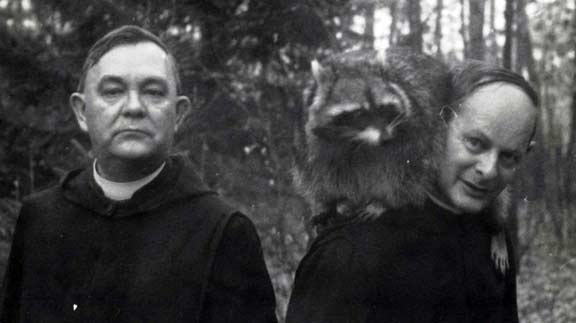
The museum history begins with the Reverends Hilary and Edmund Jurica, O.S.B. They were children of an immigrant family. Father Hilary, the elder brother, was born in Slovakia in 1892 and Fr. Edmund in Cloverdale IL. in 1900. Both joined the Benedictine Monastic Community of St. Procopius Abbey as young men. After their seminary training they were ordained Priests, and then were accepted for doctoral studies at the University of Chicago. Already this marked these men as exceptional, since most priests at that time did graduate studies at the Catholic University of America at Washington D.C. Fr. Hilary obtained his degree in botany in 1922 and Fr. Edmund in zoology in 1926.
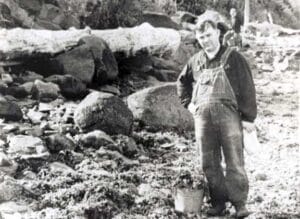
Both men then directed their considerable energy to the development of the biology department of St. Procopius College in Lisle, IL. This was the age before video, TV, cell phones, movies, computers, etc. Their tradition was that of collecting biological specimens for teaching purposes. They also planned for a museum to support their classroom academic efforts at the college.
They exchanged specimens from the Midwest with colleagues from the East Coast and the West coast. They exchanged materials with Benedictines from Europe. And where ever fellow Benedictines could be found they exchanged biological materials.
During summers, they went with their brother Anthony and his family on vacation trips “out west” with Fr. Edmund in the front seat of the car with Anthony, and Fr. Hilary in the backseat with Anthony’s wife and kids. It was the time of the “traditional American” automobile vacation with the kids (and Fr. Hilary) asking “are we there yet?” Over the years they traveled through the Dakotas, Montana, Wyoming, and out to Puget Sound in Seattle, WA.
In the classroom, as they began their teaching careers, they discovered talented students, who they put to work, assisting them in establishing their teaching collection. Besides preserving and identifying the specimens they collected on their various travels and exchanges with their professional colleagues across the country, they also began to draw a series of large biological flip charts which demonstrated the two kingdoms known at that time, the plant kingdom and the animal kingdom.
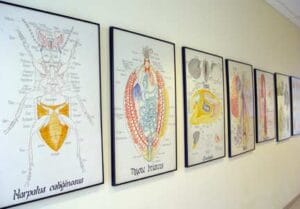
These charts were drawn from some of the original specimens they collected as the hickory tree, leaves and fruit) and also from modifying other drawings found books and articles published by their colleagues. (There was not the concern then as there is today about acknowledging the original author.)
They were creative because as the charts became well known and used throughout the country, money from the royalties came rolling in to fill the Jurica Brothers treasury. And they used that money to purchase specimens and models and microscopes for their classrooms.
Their summers were spent manufacturing microscopes slides, which were used the following school year in their classes, and some of which slides were used to obtain or purchase more specimens and models and microscopes from the Chicago based CENCO biological suppliers. (If you have the opportunity to see the video-movie ET, notice the biology chart in the scene of the frog dissection-it sure looks like the Jurica chart.)
But all good things must eventually come to an end, and the college administration soon became aware that the Jurica Brothers were making a nice little pile of money for their biology department, and pressure was put on them that the money should come to the college treasury instead of to the Jurica treasury.
Needless to say, Fr. Hilary was not at all happy about this turn of events. But the two brothers continued with their operations, making microscope slides during the summers, and trading them for whatever new biological model was now on the market.
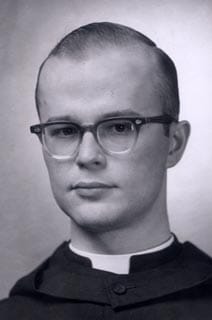
Now to the beginnings of the museum as I know it.
I made my monastic novitiate year at St. Procopius Abbey, finishing in the spring of 1962. That summer (1962) I spent the mornings in class with Fr. Hilary and earned 6 credit hours of biology credit, learning all that was needed to know about vascular and non-vascular plants. I did in about 4 weeks what took years at a university.
That fall I started taking the usual vertebrate biology classes from Fr. Edmund. Fr Edmund taught a variety of courses: comparative anatomy, genetics, advanced genetics, biology of mammals, of birds, of fish; physiology, parasitology, endocrinology, embryology, and neurology. Since a lot of the upper grade students were pre-professional, Father expected students to be properly dressed, meaning good shirt and trousers, and tie.
Father Hilary taught the freshman classes, general botany and general zoology. He then went to the Seminary where he taught Church History to the students studying for priesthood, and then to the college where he taught general psychology for the students.
And so it was that I was inaugurated into the biology life circle of the Brothers Jurica.
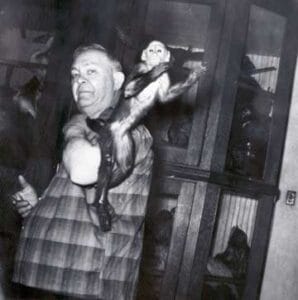
The Juricas had collected a vast amount of specimens over the years used for teaching purposes and for their longed-for future museum. These were located in the administration building (Benedictine hall), partly in Fr. Hilary’s classroom-laboratory, partly in Fr. Edmund’s classroom, and the attic.
Most of what makes up the original Jurica Collection was housed in that space.
When Scholl Hall was built, its 2nd floor, the southeast corner, had some 2500 sq feet which was to be the Jurica museum. That was the plan of Fathers Hilary and Edmund. The space used for storage of specimens in Benedictine Hall was maybe twice the space of Scholl Hall.
I got my bachelors degree (BA in philosophy in 1963: BS in biology in 1968) from St. Procopius College in 1968. And then I went to graduate school. At that time “ecology” was just beginning to become a familiar word. I figured that it would be good to learn about the ecology of our Midwest so I applied to U. of Illinois, U. of Wisconsin, and U. of Indiana. I heard from U. of Indiana first that I was accepted, so I became a “hoosier” and went there for the year and three summers.
During the summer of 1969, there began the move from the attic of Benedictine hall to the new recently completed Scholl Learning Center. The Juricas were pretty much in charge of that. I was away at grad school that summer and only heard stories about the move. It was a drain on Father Hilary’s health. He was elderly and the whole move upset his sense of orderliness and he declined rapidly. Most of the work was left to Fr. Edmund. With the help of the maintenance staff and a few favored students, Father got the collection, both teaching and museum collections moved to Scholl.
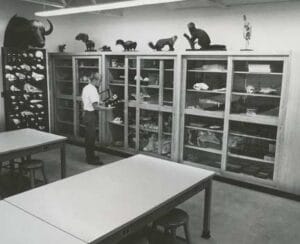
I should mention that Fr. Hilary’s classroom-laboratory in Benedictine Hall-the Ad Building–was packed, to say the least. On the ceiling hung the whale skeleton and under the whale, packed as tightly as possible, were many of the large animal mounts that would be moved to the new facility. Greeting visitors and students to father’s classroom was the orangutan mount. Alumni still tell stories how the “bad birdies,” Father’s term for mischievous students, would put a cigarette in the Oran’s mouth.
The whale (a rorqual whale BALAENOPTERA from the family BALAENOPTERIDAE) was from NW University. It hung in their old library building and when the university moved to a new library building, The University did not want the whale skeleton. Somehow Father found out about it, and with the help of some of the brothers from the Abbey disassembled and took down the skeleton, bone by bone, brought it to Procopius, reassembled and hung it up in Father’s classroom. Father Hilary told me that it was killed by a cannon ball during the civil War! And that is all I know of its history.
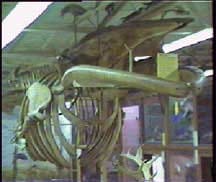
I recall only two stories about that move. One was that the center door way and main staircase were used for moving some of the large animals down from the classroom. It was a wide main entrance area and the road or college driveway was just a few feet from the main entrance door. But on the day of the move, someone forgot to tell the switch board operator about the move. And the little switch board room was almost sound proof. The men were moving the musk ox past the little window, which served also as the information window for visitors, when the operator suddenly looked up and saw this huge animal “walking” past her window. Seeing only this enormous hairy animal and no human movers visible, she belted out a scream that was hear almost in Lisle, and she just about fainted.
And the other story happened when the workmen had moved the polar bear down the main staircase and out the front door and into the pick-up truck. Then they realized that they had the bear looking out over the hood of the truck. And naturally being our college students (Procopians) they decided to take the bear for a ride through downtown Lisle. That also created quite a stir among the good town’s folk of Lisle, who were not used to seeing a polar bear in midsummer being driven around, at least not down main street Lisle. But eventually things got moved to the Scholl Museum and settled down.
Fr. Hilary died in February of 1970. And Fr. Edmund, feeling the loss of his brother, carried on as best he could, usually conducting tours for cub scouts and other visitors.
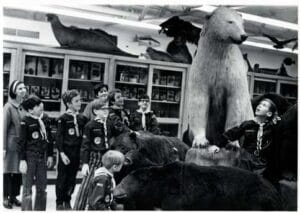
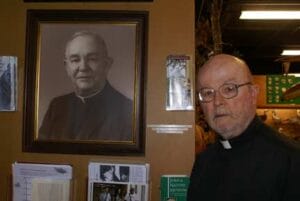
From 1970 -72, I was Instructor, College Biology Department. At the beginning of the 72 – 73 school year, I found myself appointed Assistant Professor and Acting Chair, Dept of Biology. Fr Edmund died in October 1972. The following year, I was appointed Assistant Professor and Chair of the Department of biology. In 1978, I was appointed Associated Professor and Head of the Biology Department. And in 1990 I was officially appointed “Curator of Jurica Museum.” And I have been curator, floor sweeper, window washer, fur brusher, horn and antler polisher, etc. ever since. Those early years, the museum was just a storeroom for specimens. Students, usually biology majors, were hired to conduct tours in the afternoons for cub scouts and an occasional school group. But doing tours was not really my interest. I tried to make the museum as neat and clean and presentable as possible.
Then in 1987 Dr. James J. Hazdra, formerly faculty member and chair of the Chemistry Dept, and now chief grants officer and fundraiser, obtained a grant of $10,000 from the Helen V. Brock Foundation for the museum. Now I was forced to begin the development the museum.
Two things happened. Now we had money, and could do something constructive with the museum. I contacted the Field Museum and asked if they could recommend any exhibit designer to help in designing attractive displays. They suggested Mr. Ernst Gramatzki of Burlington, Wisconsin, who proved to be the heart and soul of our new museum. And second was Dr. Branco Dragisic, a medical doctor whose relaxation was big game hunting. His son, Pete, was a student here at the time-pre-med. Dr. Dragisic was moving to a smaller house and wanted to donate some of his trophy animals to the school. The decision was made to accept the donation and so the African diorama was the first major project we undertook.
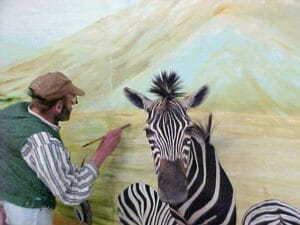
The Northern Illinois Diorama, suggested by Dr. Kamin, was the second major diorama. Dr. Kamin’s idea was to have a display of what our great State of Illinois was like before it was all paved over by shopping centers and parking lots. The diorama was to have three parts; prairie, woodland, and wetland, which were the major ecosystems of Northern Illinois. And for years, Africa and Northern Illinois were successful and popular dioramas. When we moved to Birck Hall in 2001, we moved every blade of grass, rock, and bird feather that were in the original dioramas.
Ernst did a lot of moaning and groaning about disassembling and then reassembling the dioramas. When he built something, he built it to last and he did not at all like the idea of doing it over a second time. But like the good trooper he was, he did the work.
Since 2001, the Northern Illinois diorama has been rebuilt, the prairie improved, funded by a grant from the DuPage Community Foundation;and then the next year improvements to the wetland, funded mainly by alumni. Last year (2009) the woodland was rebuilt by alumnus and current exhibit designer, David Hanke, formerly of the Field Museum and now at the Chicago Botanical Garden.

Ernst moved back to his native home of Hamburg, Germany, and after spending a year remodeling the family home into a studio where he could continue his art work, he died in September 2006 of a massive heart attack.
As Birck Hall neared completion, I was given permission to enter the new space and plan how to lay out the new museum. My High School drafting class came in very handy. I got sheets of poster board, measured out the space of the new facility, made little cardboard models of the cabinets we had, let my mind work, and moved them around the new space.
Ernst taught me that it is important with visitors to create a sense of discovery, or wonder. What was behind the next corner or bend in the road? It was important to have visitors keep moving to see what was new and yet to be discovered.
The great solid south wall suggested the African diorama. The big front windows suggested the Northern IL diorama. The rest of the wall space would be lined with cabinets or new dioramas, and there would be endless corridors made by cabinets, always with the idea-what was beyond the next corner?
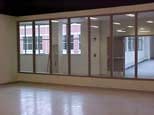
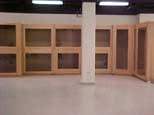
The African diorama has a story. In the first museum in Scholl Hall, Ernst painted the background scene onto the concrete building blocks. This was not an easy job as the concrete blocks were not a smooth surface, but rough concrete. And he needed patience (which was in short supply for Ernst) for the painting task. In the move to the new site, he could not very well pullout the concrete blocks and carry them over to Birck Hall and re-assemble them. So he obtained 2 massive sheets of canvas, measuring about 20 feet high and 40 feet long. These he hung up in his studio in Burlington, Wisconsin and on them he painted the African savanna. He then rolled up these great sheets of canvas and brought them to Lisle, and now how to hang them. Ernst decided on wall-paper paste to paste or glue this heavy canvas to the dry wall site of the new Africa diorama. About this time, Dr. John Mickus casually walked in to see how things were progressing. And Ernst, seeing this free labor walking in, conscripted Dr. Mickus to help him.
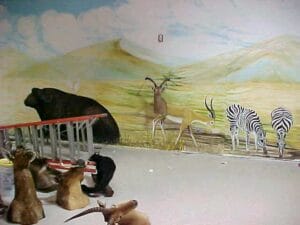
So they smeared the paste on the back of the canvas, Dr. Mickus climbed the ladder trying to hold up his end of this heavy 20 feet high by 40 feet long sheet of canvas that had to weigh at least 100 pounds, while Ernst at the other end tried to push and hold up with a long pole or 2 by 4 his end of the canvas.
The canvas did not cooperate at all, and proceeded to fall down from its place on the wall at least three times, one time falling back and covering Dr. Mickus and almost knocking him from the ladder.
Finally Ernst got a hand full of nails, several long furring strips, another ladder, and proceeded to nail the canvas at its top to the wall, while Dr. Mickus tried to smooth out the paste so no lumps could be seen. And after a few encouraging words spoken in the heat of the moment, the canvas finally adhered to the wall, and last time I looked, it was still there. I am not sure for how long however.
We had a fund drive, and friends and alumni were generous, and we purchased some new cabinets; and moved as many of the old cabinets from Scholl as could be moved, without them falling apart as we moved them. Of course, we had to disassemble–literally break apart–some of the bigger old display cabinets in Scholl, in order to move them. It was amazing: give Mary Mickus a hammer and chisel, or sledge hammer, and away she would go whacking apart those wooden cabinets in another life she must have been a carpenter or foreman of a destruction crew. She could have given Bob Villa and his program on home remodeling a run for his money. We would kid her that she had the fastest, battery operated screwdriver in the whole Chicago area. It was better for me to just keep out of her way.
How does one move a university museum? Carefully! And with a lot of student workers, volunteers, and much patience.
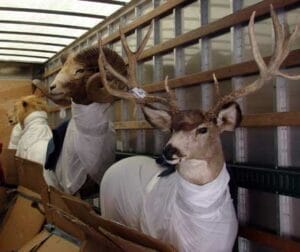
At Christmas time, the year 2000, we asked faculty, staff and everybody to save their Christmas gift tissue paper, bubble wrap, and other wrapping papers for us. We began in the spring of 2001 wrapping specimens. As we began the process, all the fossils and other specimens in storage were displayed in Ricker mounts, which are black cardboard boxes of all sizes with a clear glass front used to both store and display specimens were most carefully and neatly wrapped. As time went on, the wrapping became more hurried and less neat.
The good lord sent us an unusual angel, an alumnus with the name of Glen Thomas McAtee. Tom worked for years with professional moving companies as United movers, Van lines etc. Tom walked in one fine day, and said that he would like to do something for his old school, his alma mater. And so Tom showed us how to organize, pack, and move things without breaking our backs, or getting sore muscles.
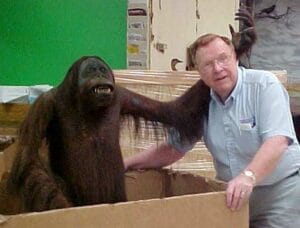
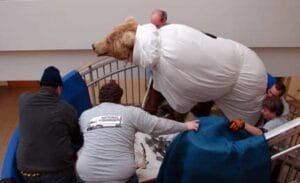
And so we moved about 10,000 items from the museum in Scholl Hall to our new museum space in Birck Hall. We had 2 and 4 wheel dollies, thick moving blankets, heavy cardboard moving packs, wood gondolas, trucks, etc.
It was not easy moving the polar bear up the winding staircase in Kindlon Hall, then over the “bridge” to Birck Hall. The bear was too big for the elevator in Birck Hall thus the staircase in Kindlon Hall had to be used-lot of moaning, groaning, and 4 letter words on that move.
Cabinets that had moveable display objects in them-such as the bottled fish and preserved turtles, had their display objects wrapped in tissue and bubble wrap, and stored in boxes marked with the cabinet number, and carried over, and then reunited-cabinet with its contents.
Other cabinets, such as those with birds wired into or glued onto the shelves were moved over as is or as was. The numbered cabinets were placed on the new museum floor according to where their corresponding number was affixed. By the time all the old cabinets were moved, and the new cabinets set up, Mary and I found that the only items broken were two bird eggs. At that we padded ourselves on the back for a “job well done”. We still kid ourselves that probably the most used word during the whole moving process was: “OOPS-I did not see that”. Now we could settle down and enjoy the fruits of our labors.
But, wouldn’t you know it; barely had we relaxed, and gotten the sweat off our faces, when opportunity knocked on our door again. Sam and Rosemary Pancotto of Oak Brook, both big game trophy animal hunters, were interested in donating about 50 of their prize trophy animal mounts to the Jurica Museum. Sam was approaching his 80th birthday and his health was not what it used to be. And Sam wanted his prizes to be appreciated and used for educational purposes.
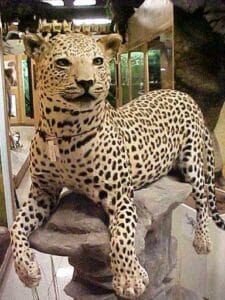
Leopard
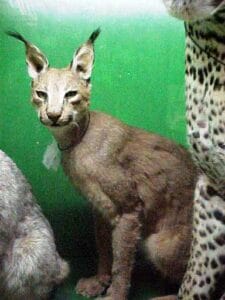
Caracal
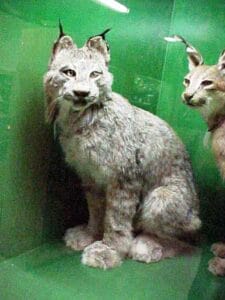
Lynx
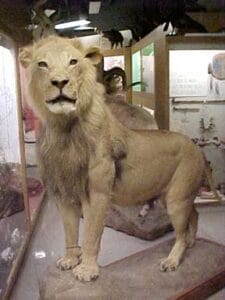
Lion
After a lot of soul searching, and debating: “Should we accept them, or not accept them.” “Where can we put them-everything is full–but in the Pancotto collection are a lot of animals that we do not have: like lions, tigers, and bears—well maybe no tigers, unfortunately, but there were lions and a bear. In the end we decided to say, that “we would be glad to accept their gift to the Jurica museum.”
With the assistance of our university’s campus services personnel, Chad and Jay, arrangements were made to bring the Pancotto collection to “Jurica.” As an aside, I visited the Pancottos at home to see what the collection was like. Imagine living in a house with about 52 large trophy animals in every room. For example: the dining room had about 7 or 8 full-bodied deer at the dining room table. I would imagine Thanks Giving Dinner would have been a ‘hoot” with all the deer looking on at the diners and watching them eat turkey.
But the Pancottos were very kind and gracious. And the newspapers gave us a great deal of publicity. I have to tell one story about them. Rosemary said that she was not about to sit at home while the men were out having a good time hunting-she went along on the hunts too. Then Sam told the story about how one trip, the guide got them to a spot known for its grizzly bears. And hunting here for these bears was encouraged at the time-they were numerous and a problem.
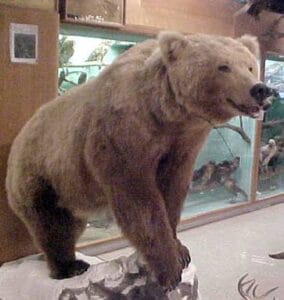
One especially large bear was pointed out to them. Sam, being the wonderful husband that he was, told his wife: “Honey you go ahead and take the shot” thinking to himself that no way could she hit that monster bear. So standing behind her, he got ready to take the shot, because he wanted to take the animal-to make the kill. But Rose, with a single, well placed shot, brought down that bear. All Sam could say was “Good shot, Rose”. And was frustrated the rest of the day.
Well the collection was brought to Birck Hall. Now to figure out how to incorporate it into the museum collection. Again, we lucked out. Mary remembered an alumnus who was both biology major and fine art student, David Hanke.
David was working for the Field Museum at the time and now works at the Chicago botanical garden. So we asked David if he would be interested in doing the design and fabrication for us, and fortunately David said “yes”.
David “cut his teeth” so to speak, for us with the renovation of the Northern Illinois woodland, incorporating the 2 white tail deer. And his water fall and stream are great examples of the quality work David does. Next was the fine rock formation with the leopards. Then the lions, Kevin, the male lion (named after the son of an alumnus and alumna who gave me a hard time about anatomy) Kevin on the termite mount and the two females hiding in the grass-and I hope you noticed the large size of that one female. I don’t think any of us would like to meet her on a hunting trip-she being the hunter.
David is now finishing up the desert diorama in a nearby room with the desert mule deer staring down a predator or two. Across from this desert diorama we are planning on an arctic display with the musk ox, caribou, wolf and several other cold adapted animals. The educational aspect will be for the student to identify as many similar and opposing traits as can be found in these two opposing ecosystems.
The last diorama and maybe the most challenging one for David will be the construction of the rocky cliff diorama in the museum near the Northern Illinois diorama. This sheep display will feature Pancotto’s two prize sheep the high Altari Sheep and the Marco Polo sheep.
And then Mary and I will breathe a sigh of relief. We are done.
~ Fr. Ted, 2010 ~
